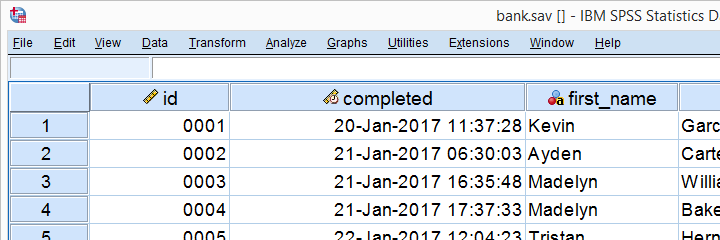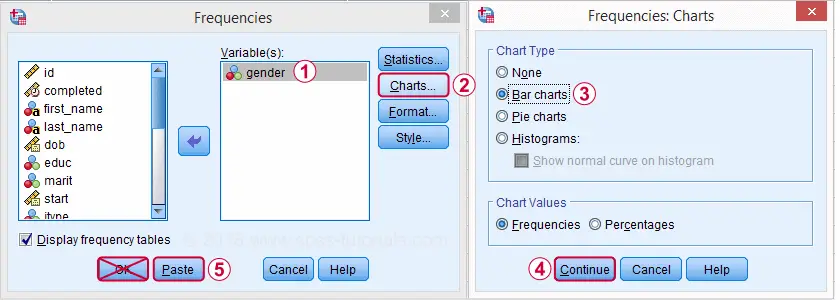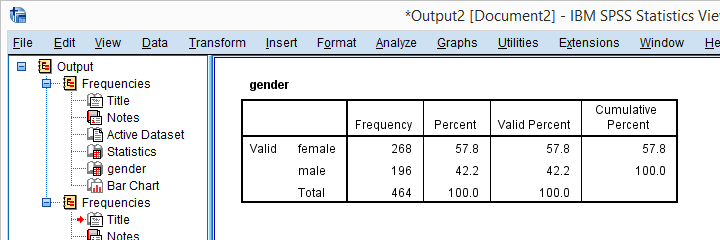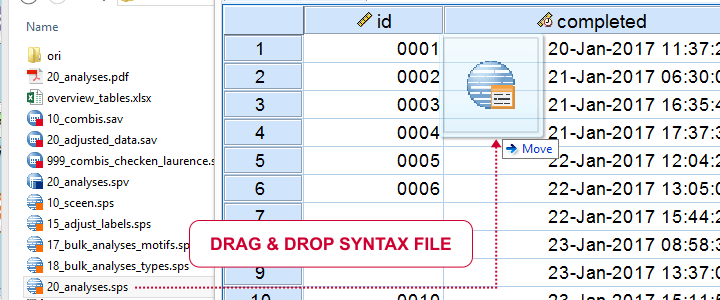Contents
SPSS syntax is a language containing instructions for
analyzing and editing data and other SPSS commands.
- How to paste SPSS syntax?
- How to run SPSS syntax?
- Writing simpler syntax
- How to get SPSS syntax?
- Why even use SPSS syntax?
SPSS users working directly from the menu may not actually see they syntax they're running. However, this is a terrible practice and we'll explain why in a minute. So let's download and open bank.sav -partly shown below- and jump right in.

How to paste SPSS syntax?
Now let's suppose I'd like to gain some insight into the percentages of male and female respondents. I could first navigate to

 as shown below.
as shown below.

I'll now  move gender into the variable box and perhaps
move gender into the variable box and perhaps  request a bar chart as well.
request a bar chart as well.

Now clicking may seem the obvious thing to do. A much better idea, however, is to click the button. Upon doing so, a new SPSS window opens which is known as the Syntax Editor. It's recognized by the orange icon ![]() in its left top corner.
in its left top corner.

The Syntax Editor contains a FREQUENCIES command which holds the instructions we just gave SPSS in the Frequencies dialog. However, we don't see the frequency distribution and bar chart we asked for. This is because we still need to run the command we just created.
How to run SPSS syntax?
The simplest way to run syntax is to select the command(s) you'd like to run and click the “run selection” icon  in your toolbar.
in your toolbar.

A faster way to run syntax is to use several shortkeys, especially
- F2 for selecting the command in which your mouse pointer is located;
- Ctrl + a for selecting all syntax;
- Ctrl + r for running all selected commands.
So let's now run our pasted syntax. On doing so, a new window will open, containing our frequency table and barchart. This is an output window which we'll discuss in our next tutorial.

How to get SPSS syntax?
The right way to do basically anything in SPSS -editing and analyzing data, creating tables and charts and more- is by running syntax. So how to get syntax? First off, using the button from the menus adds syntax to your syntax window. If you don't have a syntax window open yet, it'll open one for you. Options for opening a syntax window are
- using the button from the menus;
- drag and drop a syntax file into the Data Editor window (shown below);
- clicking the New Syntax
 toolbar icon;
toolbar icon; - Navigate to

 .
.

If you've a syntax window open, you still need the actual syntax. Options to get the syntax you need are
- use the button from SPSS’ menu;
- copy-paste syntax from our tutorials, online forums and elsewhere;
- type the commands you need into the syntax window.
Now, typing syntax may seem like a crazy thing to do at this point. However, typing syntax is much easier than it seems because most of it can be dramatically simplified.
Writing simpler syntax
The syntax we just pasted from the menu was:
/BARCHART FREQ
/ORDER=ANALYSIS.
Now typing all that manually is a lot of work. However, we'll get the exact same results if we run:
/barchart.
Just typing and running this is much faster and easier than clicking through all menu options. So if you want to get real good -and real fast- with SPSS, start learning short syntax. This will take some practice but it will save you tons of time and effort in the longer run.
SPSS Syntax Files
We can now save all contents of our Syntax Editor as a syntax file by going to
 The resulting syntax file has the .sps (for “SPSS syntax”) file extension and is a plain text file. You can open, edit and save it with SPSS or any text editor such as Notepad++.
The resulting syntax file has the .sps (for “SPSS syntax”) file extension and is a plain text file. You can open, edit and save it with SPSS or any text editor such as Notepad++.
When saving syntax in newer SPSS versions, something like
* Encoding: UTF-8.
may be added. Just leave and ignore this, it's not meant for you but, rather, some kind of “note to self” from SPSS.
Why even use SPSS syntax?
The single best SPSS practice is doing everything from syntax. Some reasons for this are
- you'll always know exactly which steps you took in which order so you can prove that your results are correct;
- if you made some mistake -don't we all sometimes?- you can correct it and rerun everything you did in just seconds;
- you'll work way faster than from the menu and you never have to do things twice;
- some of the best SPSS tricks and time savers are available as syntax only.
So say you run 10 tables and charts from the menu. And then you realize you should have filtered out all respondents working in IT. Now you have to start all over again: remove the unwanted respondents and click your way through all the same menus and dialogs again...
Sounds like a terrible idea. Doesn't it?
Unfortunately, I see students having to do days of SPSS work all over again on a daily basis. Not working from syntax really is the very worst SPSS practice.
So say I run those 10 tables and charts and I saved all syntax. Then I realize I should have filtered out all respondents working in IT. Ok. No problem. I'll just add
SELECT IF (jtype <> 3).
to the top of my syntax and rerun all tables and charts in one go.
Thanks for reading!
 SPSS TUTORIALS
SPSS TUTORIALS
THIS TUTORIAL HAS 67 COMMENTS:
By Ruben Geert van den Berg on December 5th, 2018
The right way to run SELECT IF is
SELECT IF(jtype <> 3).in which the parentheses are optional but recommended for readability.
If you run just this line, nothing seems to happen. However, zero or more cases are deleted as soon as you run a chart, table, test or EXECUTE.
The latter tutorial also explains why that's the case.
Hope that helps!
By Jacob Mortensen on February 5th, 2019
Hi there,
What if i created syntax on a bunch of data, but later added more data within the same variables? Is it possible to rerun syntax and then include the new data that I have acquired?
By Ruben Geert van den Berg on February 5th, 2019
Hi Jacob!
Yes, that's perfectly possible. Like so you can run some analyses while your questionnaire is still running to see how things are going. If you don't change any variable names, you can run the exact same syntax after more respondents have filled it in. In some companies that's standard practice.
Or if you run the same questionnaire several times per year to monitor how things are going, just 1 syntax file can do the job after each data collection.
Hope that helps!
SPSS tutorials
By Aliza Ben-Zacharia on February 13th, 2019
I liked it but I tried to have the syntax icon toolbar and was not successful. I like to have the colorful figure toolbar and it disappeared from my syntax window and I do not know how to bring the colorful quick toolbar with the green icon to run or or the three blue panel for analysis, Can you help figure it out?
By Ruben Geert van den Berg on February 13th, 2019
Hi Aliza!
First off, in the syntax window, go to View -> Toolbars. Here you can tick which toolbars should be (not) visible.
Otherwise, building your own toolbar is very easy and works much nicer than the built-in toolbars. For a quick tutorial, see SPSS Toolbar Building.
I should add that many people report problems with toolbars and I haven't experienced those myself.
Hope that helps!
SPSS tutorials